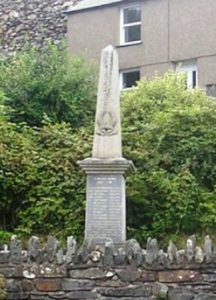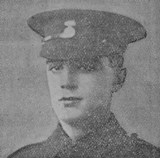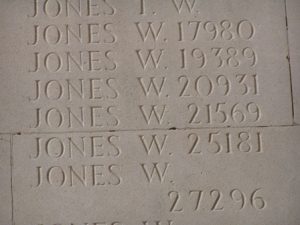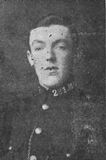Talsarnau is a village situated south of Penrhyndeudraeth, on the A496 coastal road between Maentwrog and Harlech, close to the hamlets of Eisingrug and Llandecwyn, in the ancient county of Merionethshire. Talsarnau railway station is situated on the old Cambrian Railway Line. The men of the village who fell during both World Wars are commemorated on the village war memorial, which is situated within a memorial garden in the grounds of Christ Church. The memorial takes the form of an obelisk, bearing tablets with the names of the fallen, eleven in WW1 and three in WW2.

The Great War, 1914-1918
Thomas Kinsey Hughes, Private, 25025, Royal Welsh Fusiliers. Thomas was the son of Richard and Elizabeth Hughes, of Tainewyddion, Ynys, Talsarnau. He enlisted at Penrhyndeudraeth into the 17th Battalion, Royal Welsh Fusiliers on 25 January 1915. The battalion was raised at Llandudno, joining 128 Brigade, 43rd (Welsh) Division and trained in North Wales before moving to Winchester in the summer of 1915, where the formation became renumbered 113 Brigade, 38th (Welsh) Division. The Division moved to France on 2 December 1915 and moved to the Nursery Sector near Fleurbaix for trench initiation alongside the Guards Division. The Division then held a sector of the line near Cuinchy before marching south to the Somme sector in June 1916 to take part in the assault on Mametz Wood. The first attack on the wood was launched on a two-battalion front on 7 July, but failed, and the Divisional Commander, Sir Ivor Philipps, was replaced before the Division attacked again on a two Brigade front on 10 July 1916. The Division was relieved from the wood on 14 July, after having cleared it up to its northern edge, and spent a month in the line at Hébuterne before taking over the Canal Bank sector at Boesinghe, north of Ypres. Thomas was wounded at Boesinghe on 28 February 1917 and was treated at the 131st Field Ambulance. He re-joined the battalion on 4 March, but eleven days later became ill and was evacuated back to hospital in England, being diagnosed with nephritis. Thomas arrived back in France on 3 August, and on 25 August 1917 was posted to the 16th Battalion, Royal Welsh Fusiliers. The battalion, which was attached to 113 Brigade, 38th (Welsh) Division, had just been withdrawn from the line at Pilckem Ridge, and then fought in the Battle of Langemarck before being moved to the Lys Sector for the winter. At the end of March 1918 the Division was sent south to the Somme, and relieved the battered 2nd and 47th Divisions in the line at Bouzincourt Ridge, north of Albert. Two weeks later, the 16th RWF received orders for a special operation, to clear the Germans off the high ground along Bouzincourt Ridge, and thus afford the Division the view across the Ancre Valley towards Thiepval Ridge. At 07.30 on 22 April 1918, the 16th RWF launched their assault, but was hit by heavy machine-gun fire. Only one objective was taken, due to the heavy casualties suffered by the battalion, which had over 200 officers and men killed, wounded or missing. Thomas was among those killed during the days fighting. He was 22 years old and is buried in Bouzincourt Communal Cemetery Extension, France.
W. Hughes, of Bryn Eirin, Talsarnau. This man cannot presently be identified.
John Jones, Corporal, 28023, Royal Air Force. John was the son of Richard and Margaret Jones, of Bryntirion, Talsarnau. He had enlisted into the Royal Engineers soon after the outbreak of war, and was posted to France on 21 November 1915. John later volunteered to serve with the Royal Air Force, and re-trained as an aircraft mechanic. John was stationed at Winchester when he took ill, and died at the Royal Hampshire County Hospital, Winchester on 10 March 1919, aged 25. His remains were conveyed home for burial in St. Michael’s Churchyard, Llanfihangel-Y-Traethau, six days later.
John Rees Jones, Private, 123626, Machine Gun Corps. John was the son of Rees and Annie Jones, of Tynyberth, Talsarnau. He originally enlisted into the Army Service Corps, but after completing his training was posted to the 3rd Battalion, Machine Gun Corps. The Battalion was formed from the 8th, 9th, 76th and 233rd Companies, MGC on 6 March 1918, during the re-organisation of the British Army, and was attached to the 3rd Division. The Division was facing the Hindenburg Line when it was hit by the German Spring Offensive of 21 March 1918, and fought a rear-guard action over the coming days. The battered Division was then transferred to the Lys sector to rebuild, but was caught up in the second phase of the German offensive, which was launched along the Lys Valley on 9 April. Following the epic Australian and Canadian success during the Battle of Villers-Bretonneux on 8 August, the Allies took the offensive, and on 21 August 1918 launched an offensive along the Western Front. By the beginning of October, the 3rd Division was south of Ribecourt and on the night of 7-8 October the 3rd Battalion, MGC moved forwards into positions in front of Masnières, in readiness to carry out a machine-gun barrage to support another assault by the Division. John was among 49 men of the battalion killed in action during the assault on the following morning, 8 October 1918. He was 20 years old and is buried in Grevillers British Cemetery, Bapaume, France.
William Jones, Private, 57434, Suffolk Regiment. William was the son of Charles and Jannett Jones, of Ty’n Twll, Talsarnau. His mother died when he was just three years old, and his father died when he was fifteen. William enlisted at Dolgellau into the army just after his fathers death, adding two years to his age, and upon completing his training, was drafted to France, joining the 11th Battalion, Lancashire Fusiliers. The battalion had been in France since 25 September 1915, attached to 74 Brigade, 25th Division, and had fought during the Somme offensive and at the Third Battle of Ypres in 1917. The Division was moved to the Bullecourt sector to aid the battered Divisions which had been caught up in the German Spring Offensive of 21 March 1918, then was moved to the Lys Sector, where it became caught up in terrible fighting following the launch of the second phase of the German offensive along the Lys Valley on 9 April. After suffering terrible casualties, the Division was moved to the quieter Aisne sector to rebuild, but the Germans launched the third, and final, phase of their offensive there on 27 May. The Division was almost decimated, and its troops used to provide reinforcements for other units, so William was transferred to the 12th Battalion, Suffolk Regiment. The battalion was in the process of being rebuilt in England, moving back to France on 5 July 1918, attached to 43 Brigade, 14th (Light) Division, and the Division joined the Second Army in the Ypres Salient. On 25 September the 12th Suffolk’s moved into the front line north-east of Voormezeele, taking over the notorious Bluff Sector. William was killed in action here on 28 September 1918, when his battalion attacked, and captured, The Bluff. The 18-year-old has no known grave, and is commemorated on the Tyne Cot Memorial, Belgium.
William Samuel Jones, Sergeant, 290517, Royal Welsh Fusiliers. William was the brother of John Jones, of Talsarnau. He lived at Waen Gwella, Penrhyndeudraeth prior to the war. William enlisted into the 1/7th Battalion, Royal Welsh Fusiliers prior to the war. The battalion was a Territorial unit, which mobilised for war at Newtown in August 1914, as part of North Wales Brigade, Welsh Division and moved to Conway until the end of the month, before moving to Northampton. In December the Division moved to Cambridge and then in May 1915 to Bedford, where the Division was numbered and the formation became 158 Brigade, 53rd (Welsh) Division. William served with the battalion throughout the war, but probably missed its efforts at Gallipoli, joining the battalion in Egypt in 1916. He then took part in the Palestinian campaign, which was launched during the First Battle of Gaza in March 1917, and then in the subsequent Second and Third Battles of Gaza, which led to the capture of the cities of Jerusalem and Jericho. Towards the end of the campaign, William suffered a gunshot wound to his chest, which penetrated his right lung. He was invalided home, but died as a result of his wounds at Waen Gwella on 2 January 1919, aged 30. He was buried in Holy Trinity Churchyard, Penrhyndeudraeth by the Reverend J. Hughes on the following Saturday.
William T. Jones, Private, 21569, Royal Welsh Fusiliers. William was the son of Owen and Margaret Jones, of Bryn Mair, Talsarnau. He was working as a Milk Carrier for his uncle in London when war broke out, and enlisted at Finsbury Barracks into the 15th Battalion, Royal Welsh Fusiliers. The battalion, known as the London Welsh, moved to Llandudno on 5 December 1914, joining 128 Brigade, 43rd (Welsh) Division. On 29 April 1915 the formation became renumbered to 114 Brigade, 38th (Welsh) Division and moved to Morn Hill Camp, Winchester to complete its training, before embarking for France from 2 December 1915. The Division moved to the Nursery Sector near Fleurbaix for trench initiation alongside the Guards Division. The Division then held a sector of the line near Cuinchy before marching south to the Somme sector in June 1916 to take part in the assault on Mametz Wood. The first attack on the wood was launched on a two-battalion front on 7 July, with the 15th RWF carrying out a minor operation to assist the assault, but the attackers were hit by heavy machine-gun fore and forced to withdraw. William was one of eleven men from his battalion killed during the attack that day. The 21-year-old has no known grave and is commemorated on the Thiepval Memorial, France.


Lewis Lloyd, Third Mate, Mercantile Marine. Lewis was the son of Captain Humphrey Lloyd and Margaret Lloyd, of Clogwyn Melyn, Talsarnau. He married Kate Jones, of Talsarnau, in 1907 and the couple resided at Bron Wylfa, Talsarnau. Lewis followed his father by joining the Mercantile Marine and sailed from Porthmadog. He had gained his Masters certificate in 1900, thus becoming a Captain in the Mercantile Marine, but due to commanding smaller vessels from Porthmadog, was inexperienced in larger ships, so was taken on as Third Mate aboard the Liverpool registered SS City of Lincoln following the outbreak of war. On 18 September 1917 City of Lincoln was in the Western Approaches, en-route from Holland to New York in ballast, when she was attacked by the German submarine U-106, and was hit by a torpedo and damaged. The destroyer HMS Contest received an SOS and went to her aid, taking aboard several crew members of City of Lincoln who had been injured in the explosion. While aiding City of Lincoln, Contest was herself torpedoed and sunk by U-106, which then made her escape, leaving City of Lincoln safe to limp back to port after picking up 60 survivors from Contest. Lewis appears to have been among the men taken aboard Contest, and was drowned when she was sunk that day, 18 September 1917, aged 41. Lewis has no known grave and is commemorated on the Tower Hill Memorial, London.
William Pritchard, Private, 1364, Welsh Guards. William was born in Barmouth in 1893, the son of John and Ann Pritchard. His father was a signalman for Cambrian Railways and by 1901 the family had moved to Tywyn. By 1911 the family had moved to Welshpool and William worked there as a railway porter, prior to enlisting into the Merionethshire Police in April 1914 and was posted to Barmouth. His father had by then become Station Master at Talsarnau. In May 1915 William enlisted into the newly formed Welsh Guards, which had been raised by Royal Warrant of 26 February 1915, at White City, and was posted to Prince of Wales Company. The Welsh Guards landed at Le Havre on 18 August 1915, becoming attached to 3rd Guards Brigade, Guards Division. The Division saw its first major action during the Battle of Loos, which began on 25 September 1915, and also fought in the subsequent Action of Hohenzollern Redoubt. The Guards Division wintered at Ypres and on 27 July 1916 left Ypres for the Somme. The Guards attacked the village of Ginchy on 9 September, and its subsequent capture paved the way for an assault on Flers-Courcelette. The Welsh Guards moved into Trônes Wood on 14 September, and saw for the first time the new super-weapon, the tank, which was about to make its debut on the battlefield. At 01.00 on 16 September 1916 the Welsh Guards received their orders to attack, and at midday the assault was launched, in terrible weather. William was killed in action during the heavy fighting that afternoon. The 24-year-old has no known grave and is commemorated on the Thiepval Memorial, France.

David Hughes Roberts, Private, 3755, Royal Welsh Fusiliers. David was born in Talsarnau in 1894. He enlisted into the Royal Welsh Fusiliers on 18 October 1915, and was posted to Park Hall, Oswestry for training. David had only served for three months when he began suffering from chest pains, and was found to have heart disease. He was discharged from the army as medically unfit on 20 January 1916, his condition being attributed to his military service, and returned home to Talsarnau. David married Ellen Jane Roberts in 1920, and the couple set up home together at Fron-Gelli, Talsarnau. David’s health continued to fail, and he died of heart disease at home on 17 December 1922, aged 28. David died too late for commemoration by the Commonwealth War Graves Commission, and he is also omitted from the Talsarnau war memorial, probably because it was erected before his death.
John Stuart-Wortley, Lieutenant Colonel, South Staffordshire Regiment. John was born in London on 18 July 1879, the son of the Artist, Archibald John Stuart Wortley and the Actress, Emily Eleanor Edith Wortley (nee Bromley). He was educated at Eton before joining the Mercantile Marine, and spent two years at sea, before enlisting into the Hertfordshire Yeomanry. John was then commissioned into the Egyptian Army and served during the Boer War with the 1st Scottish Horse, Imperial Yeomanry. On 28 January 1903 John was commissioned into the Cameronians (Scottish Rifles) and by 22 March had been promoted to Lieutenant. He served in the Sudan until 1912, when he returned to England, and married Edith Minnie Phillips, the daughter of Sir Lionel Phillips, later that year. The couple set up home at Maesyneuadd, Talsarnau, where they entertained many of the London elite. Following the outbreak of war, John was given command of the 21st (Public Schools) Battalion, Royal Fusiliers, and took the battalion to France. During 1917 he was transferred to take command of the 2/6th Battalion, South Staffordshire Regiment, which was attached to 176 Brigade, 59th (North Midland) Division. The Division had moved to France from Ireland in February 1917, and followed the German Retreat to the Hindenburg Line in March 1917. The Division moved to Ypres later that year and took part in the Battle of the Menin Road and the Battle of Polygon Wood. Then, in November, the Division moved back south, and took part in the Battle of Cambrai, remaining in the area over the winter. At dawn on 21 March 1918, John’s battalion was holding the Left Brigade Sector at Bullecourt, when it came under heavy artillery fire. A bombardment of gas shells followed, then at 09.00 the battalion was hit by a formation of highly trained German stormtroopers, and got caught up in desperate fighting. The British front line was wiped out, and the Germans outflanked the battalion’s survivors. By the end of the day, the first day of the German Spring Offensive, the 2/6th South Staffs reported 23 officers and 600 men missing. The battalion had been annihilated. No trace of John was ever found, so he is officially recorded as having been killed in action that day, on 21 March 1918, aged 38. He has no known grave and is commemorated on the Arras Memorial, France. John had been a close friend of the poet John Buchan, who later wrote about him.
Robert Richard Williams, Private, 315636, Royal Welsh Fusiliers. Robert was born at Talsarnau on 4 November 1881, the son of Robert and Laura Williams. His parents later resided at Tyn-Y-Buarth, Llanfair. Robert worked as a boot repairer prior to the war, when he enlisted into the Royal Welsh Fusiliers. Robert was posted to the 23rd Battalion, Royal Welsh Fusiliers, which was a Home Service battalion, based in Norfolk with 224 Brigade, and performed coastal defence duties. Robert died at Cambridge Military Hospital on 5 September 1917, aged 35. His remains were brought home for burial in St. Michael’s Churchyard, Llanfihangel-Y-Traethau. He is also commemorated on the Llanfair and the Harlech memorials.
World War Two, 1939-1945
R H Griffith, Quartermaster, of Bryntirion. This man cannot presently be identified, but a Robert Henry Griffith, born in Talsarnau in 1890, is recorded as having joined the Merchant Navy in 1921. No man of that name is recorded as being an official casualty of WW2.
David Blackwood Maybury, Corporal, 4193315, The Parachute Regiment. David was born in Liverpool in 1915, the son of William George Maybury and Emily Jane Maybury (nee Pritchard). His mother was Welsh, and the family came to live at 3, Bryn Street, Talsarnau. David married Katherine Pugh in 1936. He enlisted into the Royal Welch Fusiliers following the outbreak of war, and later volunteered to serve in the newly formed Parachute Regiment. He completed his training in February 1944 and was posted to the 9th Battalion, Parachute Regiment. David then took part in the mass airborne drop during the early hours of the D-Day landings of 6 June 1944. His next airborne drop was during the last such operation of the war, Operation Varsity, when troops were dropped to cover the Rhine Crossing on 24 March 1945. The operation involved 16,000 troops and is still the largest airborne operation in a single day. As part of the operation, David’s Battalion was detailed to capture the village of Schnappenberg. The village was successfully captured just after noon, but David had been killed during its capture that day. He was originally buried on the battlefield, near Merr, Germany but after the war his grave was exhumed and re-interred in Reichswald Forest War Cemetery, Germany.
Robert Gwilym Williams, Sergeant, 2218917, Royal Air Force Volunteer Reserve. Robert was the son of Madge Williams, of Derwydd, Talsarnau. He enlisted into the Royal Air Force Volunteer Reserve, and after training as an Air Gunner was posted to 101 Squadron, RAF, which was a specialist unit, equipped with Avro Lancaster’s which had been fitted with top secret radio jamming equipment, codenamed “Airborne Cigar” (ABC). These Lancaster’s had an extra, eighth, crew member who could understand German, which operated the ABC equipment, and jammed German fighter controller’s broadcasts. Early in the morning of 15 October 1944, Robert took off from RAF Ludford Magna aboard Lancaster I, Serial LL774, on an ABC mission over Duisberg, Germany. The aircraft was lost at sometime in the night, with all eight of her crew. Robert was 21 years old when he died that morning, and is commemorated on the Runnymede Memorial, Surrey, alongside his crew. 101 Squadron had the highest casualty rate of any RAF Squadron during the war.